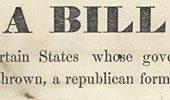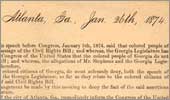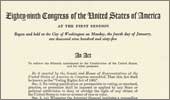
Was Reconstruction a Revolution?
Summary:
Students will examine several historical congressional records from the Reconstruction period to assess whether the documents show evidence that the Reconstruction period of American history should or should not be viewed as a revolution.
Rationale:
Students will develop analytical skills by working with primary sources and will appraise each document's value as a contribution to understanding the historical relevance of the Reconstruction time period.
Guiding Question:
To what extent was Reconstruction a revolution?
Materials:
7 Document facsimiles
1 Handout
Recommended Grade Levels:
Grades 10 – 12
Courses:
American history; U.S. government
Topics included in this lesson:
Reconstruction, revolution, civil rights, suffrage, voting rights
Time Required:
Steps 1-6 can be done in 45 minutes; Step 7 takes 45 minutes
Vocabulary:
- Civil Rights
- Reconstruction
- Suffrage
- Abridge
- Despotism
- Republican form of government
Documents:
 Wade-Davis bill as amended, May 4, 1864; Original House bills (HR 38A-B1); 38th Congress; Records of the U.S. House of Representatives, Record Group 233; National Archives, Washington, DC. View in National Archives Catalog
Wade-Davis bill as amended, May 4, 1864; Original House bills (HR 38A-B1); 38th Congress; Records of the U.S. House of Representatives, Record Group 233; National Archives, Washington, DC. View in National Archives Catalog
 Petition of colored voting citizens of McMinn County, Tennessee praying for enforcement of the 14th Amendment, endorsed March 2, 1874; Petition referred to the Judiciary Committee (SEN 43A-H11.1); 43rd Congress; Records of the U.S. Senate, Record Group 46; National Archives, Washington, DC. View in National Archives Catalog
Petition of colored voting citizens of McMinn County, Tennessee praying for enforcement of the 14th Amendment, endorsed March 2, 1874; Petition referred to the Judiciary Committee (SEN 43A-H11.1); 43rd Congress; Records of the U.S. Senate, Record Group 46; National Archives, Washington, DC. View in National Archives Catalog
 S. 1, Sumner Civil Rights bill, introduced December 1, 1873; Senate bills considered in the House (HR 43A-C1); 43rd Congress; Records of the U.S. House of Representatives, Record Group 233; National Archives, Washington, DC. View in National Archives Catalog
S. 1, Sumner Civil Rights bill, introduced December 1, 1873; Senate bills considered in the House (HR 43A-C1); 43rd Congress; Records of the U.S. House of Representatives, Record Group 233; National Archives, Washington, DC. View in National Archives Catalog
 Memorial of the Board of President and Directors of the St. Louis Public Schools against the school integration clause of the Civil Rights bill, endorsed June 16, 1874; Committee on the Judiciary, petitions and memorials referred to committees (HR 43A-H8.3); 43rd Congress; Records of the U.S. House of Representatives, Record Group 233; National Archives, Washington, DC. View in National Archives Catalog
Memorial of the Board of President and Directors of the St. Louis Public Schools against the school integration clause of the Civil Rights bill, endorsed June 16, 1874; Committee on the Judiciary, petitions and memorials referred to committees (HR 43A-H8.3); 43rd Congress; Records of the U.S. House of Representatives, Record Group 233; National Archives, Washington, DC. View in National Archives Catalog
 Memorial of colored people of Georgia in favor of the Sumner Civil Rights bill, January 26, 1874 (endorsed February 3, 1874); Committee on the Judiciary, petitions and memorials referred to committees (HR 43A-H8.3); 43rd Congress; Records of the U.S. House of Representatives, Record Group 233; National Archives, Washington, DC. View in National Archives Catalog
Memorial of colored people of Georgia in favor of the Sumner Civil Rights bill, January 26, 1874 (endorsed February 3, 1874); Committee on the Judiciary, petitions and memorials referred to committees (HR 43A-H8.3); 43rd Congress; Records of the U.S. House of Representatives, Record Group 233; National Archives, Washington, DC. View in National Archives Catalog
 House Joint Resolution proposing the 15th amendment to the Constitution, December 7, 1868; Enrolled Acts and Resolutions of Congress, 1789-1999; General Records of the United States Government, Record Group 11; National Archives, Washington, DC. View in National Archives Catalog
House Joint Resolution proposing the 15th amendment to the Constitution, December 7, 1868; Enrolled Acts and Resolutions of Congress, 1789-1999; General Records of the United States Government, Record Group 11; National Archives, Washington, DC. View in National Archives Catalog
 An act to enforce the fifteenth amendment to the Constitution of the United States and for other purposes (the Voting Rights Act of 1965), August 6, 1965; Enrolled Acts and Resolutions of Congress, 1789-1999; General Records of the United States Government, Record Group 11; National Archives, Washington, DC. View in the National Archives Catalog
An act to enforce the fifteenth amendment to the Constitution of the United States and for other purposes (the Voting Rights Act of 1965), August 6, 1965; Enrolled Acts and Resolutions of Congress, 1789-1999; General Records of the United States Government, Record Group 11; National Archives, Washington, DC. View in the National Archives Catalog
Learning Activities:
- What is a revolution?
Introduce the guiding question to students and hold a class discussion about revolution. What is a revolution? What other topics have students studied that were called revolutions? What features made them revolutionary? What might you expect to see if a revolution indeed occurred? Write student responses on the board for later reference.
- Document analysis in groups
Divide students into six groups. Provide each group with a different featured document to analyze which may contribute to an answer to the guiding question. Do not include the Voting Rights Act. Students will answer the questions on the Document Analysis worksheet.
- Groups report to class
Each group will select a spokesperson to report back to the whole class with information about their document. The spokesperson should describe the document, point out relevant features or quotes from the document which relate to the guiding question, then present the group's appraisal of whether that particular document supports or contradicts the hypothesis that Reconstruction was a revolution. All students should listen closely to their classmates' reports in order to contribute to class discussion of the guiding question. Notes on all the documents can be taken on the second page of the worksheet.
- Discuss guiding question
Taking into account information from all six of the documents as well as the introductory discussion on revolutions, ask the students in their groups to take three minutes to consider the guiding question. Ask volunteers to share their answers with the class.
- Examine the Voting Rights Act of 1965
Project on a screen or distribute to each group the Voting Rights Act of 1965.* Hold a class discussion on this document. Ask students to compare the date of this document to the date of the constitutional amendment it was created to enforce. Why did this document come 95 years after the 15th Amendment? Was it part of the same revolution as Reconstruction? Or is it part of a new revolution? Was there a revolution? Does this document change your answer to the guiding question? Why or why not?
* Note: Only the first page of the Act should be used, and for this activity, students do not need to read the full page. The most relevant information to read is from the top to the title line immediately after the large type "An Act."
- Re-examine answers to guiding question
Return to full class discussion of the guiding question—to what extent was Reconstruction a revolution? Do you have enough information to answer that? What other information would be helpful to have to answer the question? What other documents or sources should be examined to help answer the question? After discussion students can write in their final answers in the last blank on the worksheet.
- Lesson extension
Ask students what document, if it exists, could help answer the guiding question. Brainstorm a list of questions that remain unanswered after having reviewed the documents as well as questions raised by the documents themselves. Direct students to create the "missing" document complete with details such as letterhead, stamps, handwritten notes, images, etc., and then explain how this document fills in the hole in the story. Have students explain the likelihood/possibility that something like this document actually exists, and if so where.
Additional Resources:
Black History—information on records at the National Archives and links to other resources.
"Freedmen's Bureau Records: An Overview" by Elaine C. Everly. Prologue, Summer 1997, Vol. 29, No. 2.
If you have problems viewing this page, please contact legislative.archives@nara.gov.